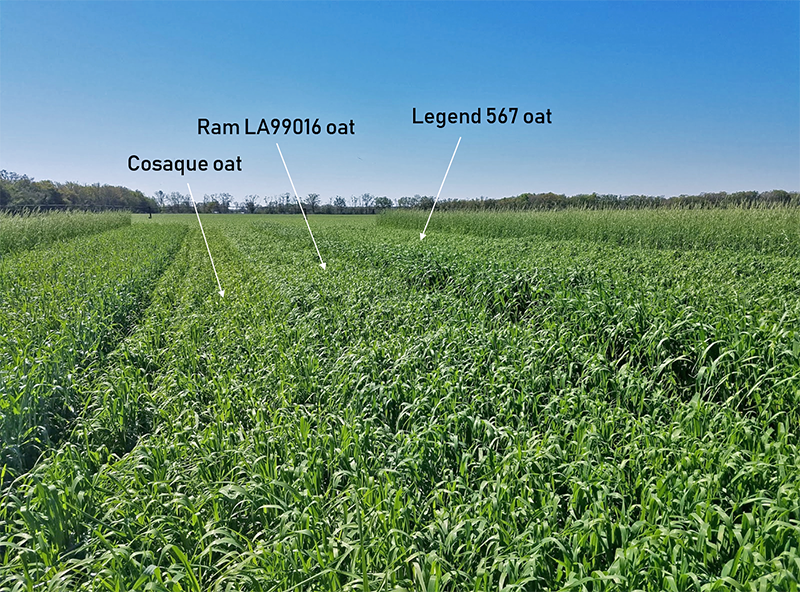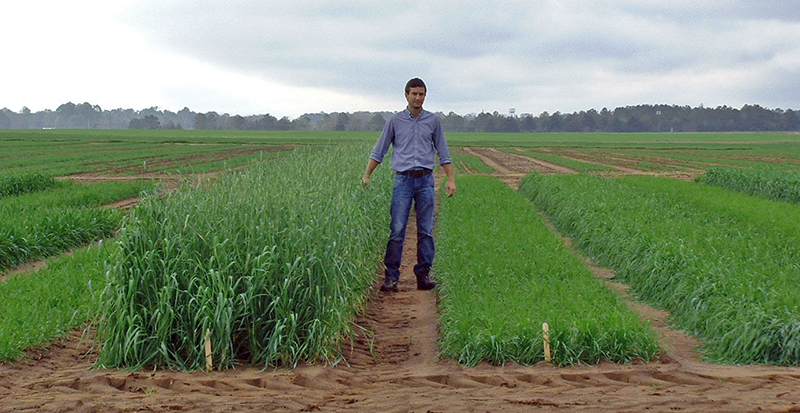
Cool-season demonstration site in Lafayette Co., showing three different oat materials. All plots were planted at the same time and received the same aount of nutrients via slurry application. Coker is a material developed for Oklahoma, a much later variety compared to LA RAM our Legend 567, which was developed for dairy producers in North Florida, aiming for rust resistance and early maturity. Credit: Macrello Wallau, UF/IFAS
Esteban Rios, Ken Quesenberry, Kevin Kenworthy, Ann Blount, Ali Babar and Marcelo Wallau, UF/IFAS Agronomy Department
Local Focus
In every extension program presentation, we always recommend and emphasize the importance of our locally-bred forage varieties. There is one very important reason for it, and it is not about royalty generation, those varieties were developed for Florida producers, targeting the needs of different sectors of our agricultural industry, and for different regions in the state of Florida. Our collaboration with producers and Extension Faculty conducting on-farm trials help us to identify the major struggles of current forage materials, and target our focus on what is most needed for each production system. The UF/IFAS Forage Breeding team has released over 47 forage cultivars over the past several years, and that is not including biofuel and turfgrasses. Those novel varieties range from bahiagrass with extended forage production season, to nematode-resistant clovers and tetraploid ryegrasses, reducing costs and increasing productivity. Rust-resistant small grains helped producers by reducing the need for supplemental winter feed and creating new niches for beef cattle producers: backgrounding stockers in integrated livestock-cropping systems. Our current efforts on bermudagrass breeding for dairy farmers can help reducing nutrient leaching by increasing slurry application capacity, while other lines being developed for beef cattle producers aim to increase the efficiency of nutrient use, requiring less fertilizer while still providing good quality forages.
The University of Florida’s Forage Breeding Program is very actively collaborating with forage researchers at the University of Georgia, University of Kentucky, North Carolina, Clemson, Auburn, Texas A&M, and Louisiana State Universities, and with scientists at the USDA-ARS (CPES, Tifton, GA) and USDA-NRCS (Brooksville, FL and Americus, GA). They are also an active member of the SUNGRAINS consortium, a six-university cooperation of plant breeders who work collaboratively on small grains (oat, wheat, triticale and rye) variety development. Since 2005, over 75 % of the new southern forage cultivars released by public institutions in the southeastern U.S., were developed or co-developed by UF’s Forage Breeding Program.
Some of the recent materials released by the team include the long-season UF-Riata Bahiagrass, the nematode-resistant Ocoee white clover, Barduro red clover with nematode resistance and later dormancy, two limpograss cultivars – Kenhi and Gibtuck – that have higher forage production and quality than the traditional Floralta, several annual ryegrasses, rust-resistant Legend 567 oat and many more. New expected releases include bermudagrass/stargrass cultivars, a 2,4-D resistant red clover, a new tetraploid annual ryegrass, and a novel alfalfa selection adapted to North Florida, with genetics derived from the old successful alfalfa varieties such as FL77 and FL99.

Cool-season variety and cultivar selection can make a significant impact on how quickly or late forages can be grazed each year. Credit: Ann Blount, UF/IFAS Extension
International Impact
Our impact goes much beyond the U.S. border. Due to Florida’s location in a sub-tropical/temperate zone, research in forage breeding at UF/IFAS has spanned the spectrum of cool-season and warm-season species. The unique environment with a cool-temperate winter and humid tropical summer offers special opportunities for screening for disease and insect and nematode pest resistance, frost-freeze tolerance, water and nutrient stress response, and plant-animal responses. Our integrated team composed of multidisciplinary scientists in forage programs (breeding, forage management, animal response, etc.) have enabled us to develop new cultivars with a spectrum of desirable traits for producers, and it has sparked interests in the international community. At present, we are developing a long-term research agreement with UNNE, at Corrientes Argentina to co-develop forages for North and South America. Similarly, collaborations with EMBRAPA forage specialists in Brazil will help us expand our knowledge and germplasm on two critically important genus for Florida, Paspalum (bahia) and Arachis (peanut). Recently, we began a collaboration to develop forage small grains for western Australia. Because of the great history and strong connections, UF/IFAS Agronomy Department is hosting the International Forage and Turfgrass Breeding Conference (IFTBC), in Lake Buenavista, FL, from March 24 to 27, 2019. The IFTBC is the first joint meeting of the 10th Molecular Breeding of Forages and Turf Conference (MBFT), and the 6th International Symposium of Forage Breeding (ISFB). The IFTBC will bring top-tier researchers from all over the world to share experience and visit our programs at the University of Florida. It will be a great opportunity for interacting and learning from folks from all over the world.
For more information on the conference or on the UF/IFAS Forage Breeding Team, use the following links:
Forage Breeding and Genomics Lab
High achievements
In 2018, Commissioner of Agriculture Adam Putnam named Dr. Ann Blount as the Woman of the Year in Agriculture for her extensive work for the producers in our state. Dr. Blount has always gone beyond her duties as forage breeder, going out of her way to help producers all over Florida, and other states in our region. Congratulations Ann!
- Does Planting Perennial Peanut in Bahiagrass Pastures Pay Off? - March 8, 2024
- Results from the 2023 UF/IFAS Silage Corn, Sorghum, and Millet Variety Trials - January 19, 2024
- Managing the Effects of Excessive Heat in Silage Corn and Other Crops - September 15, 2023
